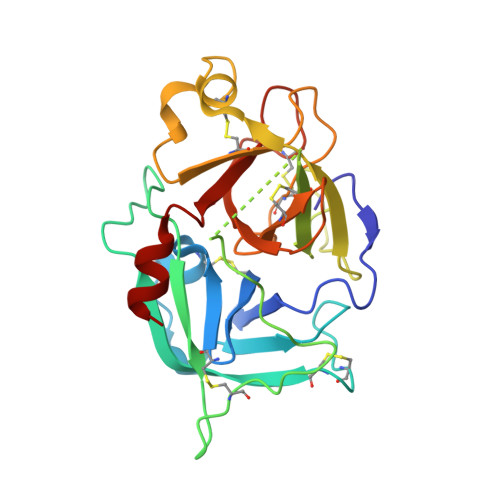An Ultrapotent and Selective Cyclic Peptide Inhibitor of Human beta-Factor XIIa in a Cyclotide Scaffold.
Liu, W., de Veer, S.J., Huang, Y.H., Sengoku, T., Okada, C., Ogata, K., Zdenek, C.N., Fry, B.G., Swedberg, J.E., Passioura, T., Craik, D.J., Suga, H.(2021) J Am Chem Soc 143: 18481-18489
- PubMed: 34723512
- DOI: https://doi.org/10.1021/jacs.1c07574
- Primary Citation of Related Structures:
7FBP - PubMed Abstract:
Cyclotides are plant-derived peptides with complex structures shaped by their head-to-tail cyclic backbone and cystine knot core. These structural features underpin the native bioactivities of cyclotides, as well as their beneficial properties as pharmaceutical leads, including high proteolytic stability and cell permeability. However, their inherent structural complexity presents a challenge for cyclotide engineering, particularly for accessing libraries of sufficient chemical diversity to design potent and selective cyclotide variants. Here, we report a strategy using mRNA display enabling us to select potent cyclotide-based FXIIa inhibitors from a library comprising more than 10 12 members based on the cyclotide scaffold of Momordica cochinchinensis trypsin inhibitor-II (MCoTI-II). The most potent and selective inhibitor, cMCoFx1, has a pM inhibitory constant toward FXIIa with greater than three orders of magnitude selectivity over related serine proteases, realizing specific inhibition of the intrinsic coagulation pathway. The cocrystal structure of cMCoFx1 and FXIIa revealed interactions at several positions across the contact interface that conveyed high affinity binding, highlighting that such cyclotides are attractive cystine knot scaffolds for therapeutic development.
Organizational Affiliation:
Department of Chemistry, Graduate School of Science, The University of Tokyo, Tokyo, 113-0033, Japan.
















